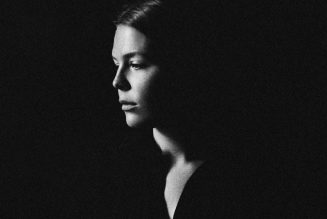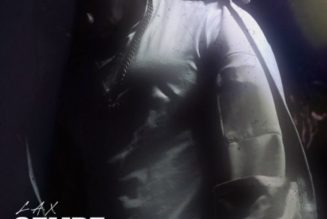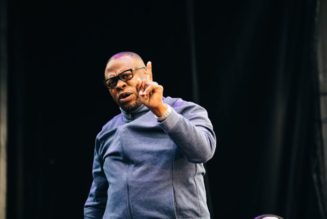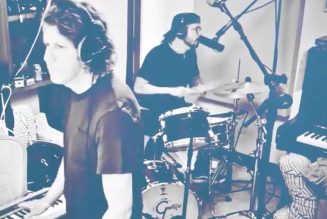
By Dani Blum
Grace Cummings makes songs that sound like she’s ripping them raw from her throat. The Australian singer-songwriter wails and howls and shudders; this is intense, intricate folk music that seems physically taxing, as if she’s fighting to drag each ragged syllable out of her mouth. Her voice is the main event. There’s an urgency inherent in her shaking vocals, the sense that, between lyrics about Stetson hats and Townes Van Zandt, she is desperately trying to tell you something. But when asked what any of the lovely, lilting songs on her new album, Storm Queen, actually mean, she refuses to answer. “Good try,” she says with a laugh.
Over a Zoom call from Australia, Cummings looks at the carpet and the dark studs of polish on her nails. A guitar leans against the wall next to her. A knot of hair trembles above her forehead when she giggles. It’s morning in Melbourne, the city that’s had the strictest coronavirus lockdowns in the world, and the government is grappling with another wave of restrictions as the Omicron variant surges. Cummings seems tense, folded on a chair, sometimes pressing down absent-mindedly on the tattoo of a rose blooming on her bicep.
It’s not that there’s no backstory to Storm Queen, she notes — the themes and through-lines are clear to her, but those connections are so intensely personal that only she could make them. She wants the record to resonate with people beyond her intentions or scope. “The things that I like about all the music that I love is that, if it’s good, it sounds like it’s written just for me,” she says. All art is like that, she believes, or should be.
Cummings released her first official album, Refuge Cove, in 2019, but she considers Storm Queen to be her real debut. That previous record was more of a collection of songs she’d pieced together after Eric Moore from Australian indie label Flightless Records and the psych band King Gizzard & The Lizard Wizard reached out; he asked if she had an album, and she sent in a group of songs. Storm Queen, out today (January 22), is the only project she crafted intentionally as a cohesive record, a prospect she found more energizing than pressured. She describes the writing process as “like a little wave,” tracing an idea until she finds its center.
Cummings doesn’t have a process for getting her voice to the staggering, stunning tone that comes through in her songs, perhaps most notably on “Heaven” and “Freak.” The studio environment feels natural to her, she says, and she tries to minimize the thoughts in her head as she records, taming her impulse to analyze. She centers on fully inhabiting a feeling. There’s no structure to her songwriting process, either – “I’m really not good at, and sometimes pretty fiercely against, trying to get something out that isn’t there,” she says. “Or trying to perfect something. Unless it’s happening, it’s not going to happen.”
She doesn’t start with emotions in her songs; emotion is what comes after everything else, she says. She thinks and writes in images, and chases the feeling that follows. On Storm Queen, many of those images revolve around cowboys, like the Stetson hats in “Heaven” and the country tune she alludes to in “No Time for Dying.” “What a cowboy is to me is almost what a unicorn is to me,” she says. “It’s this magical creature, this thing that nobody actually is. It’s a picture of freedom, getting on your horse and just fucking riding.”
It’s not a coincidence that she became so enchanted with that picture of freedom. She doesn’t classify the record as a “pandemic album” — “I don’t really want to give the pandemic any more fucking attention,” she jokes — but she wrote most of the songs during lockdown not long before she recorded the project. She kept tweaking the lineup afterward, stashing five songs here, adding others there. She wrote the title track about a week before recording; at her shows, she likes playing songs that are fresher, when the meaning still reverberates. Some of the songs were composed right after brush fires swept through Victoria, just before the pandemic set in. The sky was gray; the air felt boiling hot. She couldn’t go outside because the smoke was so thick. Looking out the window in front of her piano, she felt divorced from reality. “It was like I wasn’t a part of any kind of world that was real,” she says. “It was just too much. And also too boring.”
The real world, the natural world, has long been a comfort for her. She grew up as the youngest of three kids, with lots of imaginary friends, collecting gum leaves and rocks out of the garden. Her mother would hear Grace wake up at 3 a.m. and talk to her collection of foliage and stones. She listened to Neil Young and Bob Dylan and The Beatles; when she was 8, she painted her bedroom wall with lyrics to “Here Comes the Sun” and “I Am the Walrus” next to a peace sign. She used to lie under a blanket-covered table in her room and listen to music, writing the lyrics she heard on the underside of the table. It was a way to stake her claim on the songs she loved, saving little scraps that felt like they were just for her.
Years ago, Cummings saw a van Gogh painting at an exhibit and felt it was also made for her. She knew that it was of the artist’s doctor, the swirled strokes forming a man slouched over a table in despair, but she felt such a connection to the artwork, the exhaustion, pity, and pleading in the doctor’s eyes. “The look in his eyes is like, ‘Come on, Vincent,’” she says, her voice heavy. “It was almost like he was saying to me, ‘Come on, Grace.’” She stood in front of the painting for 45 minutes, she says, unable to walk away from the desperation frozen on the canvas.
That sense of anguish reverberates throughout Storm Queen. “What do you write about if it’s not pain and pleading and love and death and all that shit?” she asks. There are moments on the record when the emotion cracks through and overpowers. She recorded the title track last, and finished writing it five days before; “I wanted it to be really ugly and quite jarring,” she says. She captured the first take live with a guitar player and brought in a saxophone player. As he played, Cummings sat on a stool and watched him. “I just lost my mind,” she says. “I had this thing in my head when I was writing it, and I described to him how I wanted him to play and what I wanted it to feel like, and he just did it so perfectly.”
She forgot that her mic was still on, and she started laughing because she was so thrilled with the sound. On the last track of the album, if you listen closely enough, you can hear the band whooping as she finished the take; she only realized that as she played the record over and over again during mixing and mastering. She doesn’t know how to describe the experience of listening to her songs over — “I’m sure there’s a German word for it,” she jokes — but the sensation of reaching back to a past self haunted her. She could chart her growth in the recordings, the progress she’s made. She thinks she’s getting better at saying what she means.










Tagged: music